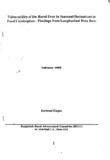| dc.contributor.author | Haque, Karimul | |
| dc.date.accessioned | 2019-11-19T06:09:55Z | |
| dc.date.available | 2019-11-19T06:09:55Z | |
| dc.date.issued | 1995-02 | |
| dc.identifier.citation | Haque, K. (1995, February). Vulnerability of the rural poor to seasonal fluctuations in food consumption: findings from longitudinal data base. Research Reports (1995): Economic Studies, Vol - X, 1–20. | en_US |
| dc.identifier.uri | http://hdl.handle.net/10361/13014 | |
| dc.description.abstract | The study focuses on food consumption and vulnerability of the rural poor to seasonal variations in food consumption. The information for this study is derived from the Village Study Project (VSP) data on daily food consumption and household's income and expenditure in 13 VSP villages. The sample villages were selected from two clusters of BRAC programme, concentrations, namely Jessore and Jamalpur. The two regions have spatial, topographic differences along with variations in socio-economic indicators. In selecting the villages factors like income distribution pattern, occupational distribution, political characteristics , land ownership and distribution, labor force participation, pattern of economic activities, category of rural institutions, literacy rates, health and sanitation etc. were taken into consideration so as to ensure that these represent a typical Bangladeshi village . A total of 459 target households (RDP member and non-member) were purposely selected for the study. The dietary sample consisted of 1,865 target population in the two study locations. The study on dietary intake was conducted by 24 hour recall method of food eaten by individual members of the study households.
The data presented in this study cover two agricultural periods the peak period and the lean period. The data in each period was collected in four rounds. The peak .period data was collected in Mid -December through Mid- February 1991 while the lean period data was ' collected in Mid-September through Mid November 1991-92. The pre Amon harvest time is defined as the peak season while the post Amon harvest time is defined as the lean season. Two seasons were selected purposively to capture seasonality of food and nutrient intake for both RDP member and non-member households. The study came up with a number of important findings. These are as follows:
1. The food consumption of both RDP and non-RDP group member was observed to be rice dominating in both the seasons.
2. In peak season Rice, alone contributes to 82% of total calorie and 63 % of total protein consumption for RDP member and 85% and 71% respectively for non-RDP member.
3. In lean season, Rice alone contributes to 82% of total calorie and 72% of total protein for RDP members and 85% and 70% respectively for non-members. As was observed that in both the reference seasons the major contributor to the daily intake of calorie and protein was rice.
4. It was observed that food consumption was not equally distributed between the seasons and between the rural poor belonging to the RDP member and non-member within the season. The consumption of food intake in peak season was higher than in the lean season. This difference in consumption between these two reference seasons can be attributed to a number of differentials particularly in terms of availability and scarcity of food, employment and income.
5. The food consumption for RDP member in both the seasons was observed to be better than the non-member. The overall I calorie for RDP member in peak and lean season was respectively was 2202 and 2007 kcals while for that of non-member it was respectively 2009 and 1827 kcals . The non-members were found to from greater nutritional stress compared to the RDP members.
6. In the same way the percentage share of rice to the total daily protein for both RDP member and non-member was higher in the peak season- indicating that the nutritional stress in the lean season was greater than the peak season and the life style of both RDP member and non-member in terms of daily diet was relatively little better in the peak season.
7. The calorie and protein consumption during the pre-Amon harvest was far below than that of what was recommended to be minimum (2310 kcals and 64 gram protein) for healthy life. The overall conclusion which follows from the analysis of data on calorie consumption that for both RDP member and non-member the peak season presents a better picture compared to the lean season because the diet in the lean season reveals one malnourished and underfed situation resulting from consumption of calorie far below poverty intake. | en_US |
| dc.publisher | Bangladesh Rural Advancement Committee (BRAC) | en_US |
| dc.subject | Seasonal fluctuations | en_US |
| dc.subject | Food consumption | en_US |
| dc.subject.lcsh | Food consumption--Developing countries--Seasonal variations. | |
| dc.subject.lcsh | Malnutrition--Developing countries | |
| dc.title | Vulnerability of the rural poor to seasonal fluctuations in food consumption: findings from longitudinal data base | en_US |
| dc.type | Research report | |

